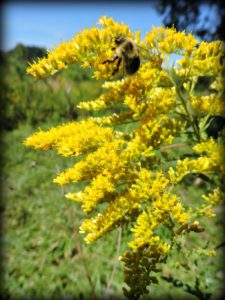Name: Goldenrods, various species
Botanical Name: Solidago spp.
Form: wildflower
Parts Used: seeds, greens
Citation: Guenther, K. (2017, January 12) Goldenrod as wildlife food [Web log post.] Retrieved: readers supply the date, from http://wildfoods4wildlife.com
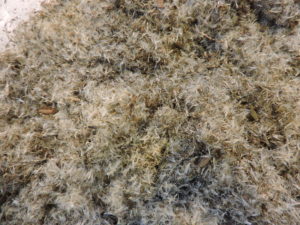
Getting Started
Asteraceae ( Aster family)
Asteroideaea (Aster subfamily)
Astereae (Aster tribe)
Solidago (Goldenrod genus)
Hooray! All our many, many goldenrods are native plants! It’s never hard to collect lots of goldenrod seed. And you really can’t clean this seed from its pappus hairs, so there is almost no work! Goldenrods rank 22nd on our Great Greens listing and 36th on our Super Seeds list.
There is something readily visually identifiable about almost all goldenrod species’ flowers; the tiny, bright, yellow masses of late summer flowers that tower at or above one’s head, and the distinctive smell of the crushed leaf. Learn this scent, and you can identify goldenrod when it is not in flower.
| Common name | Virginia Solidago Species | Origin | Rare Plant Status |
| Canada goldenrod | S. altissima | native | yes, in some states (not Virginia) |
| Atlantic goldenrod | S. arguta | native | yes, in some states (not Virginia) |
| white goldenrod | S. bicolor | native | not rare |
| wreath goldenrod | S. caesia | native | yes, in some states (not Virginia) |
| Canada goldenrod | S. canadensis | native | not rare |
| Curtis goldenrod | S. curtisii | native | yes, in some states (not Virginia) |
| mountain goldenrod | S.curtisii var. flaccidifolia | native | Globally secure, vulnerable in Virginia |
| showy goldenrod | S. erecta | native | yes, in some states (not Virginia) |
| gorge goldenrod | S. faucibus | native | Globally imperiled and at risk of extinction, vulnerable in Virginia |
| pine barren goldenrod | S, fistulosa | native | not rare |
| not rare | |||
| zigzag goldenrod | S. flexicaulis | native | yes, in some states (not Virginia) |
| giant goldenrod | S. gigantea | native | not rare |
| shale barren goldenrod | S. harrisii | native | not rare |
| hairy goldenrod | S. hispida | native | Globally secure, vulnerable in Virginia |
| early goldenrod | S. juncea | native | not rare |
| lance-leaf goldenrod | S. lancifolia | native | yes, in some states (not Virginia) |
| Elliott’s goldenrod | S. latissimifolia | native | Globally secure, imperiled in Virginia |
| gray goldenrod | S. nemoralis | native | not rare |
| anisescented goldenrod | S. odora | native | yes, in some states (not Virginia) |
| roundleaf goldenrod | S. patula | native | yes, in some states (not Virginia) |
| small’s goldenrod | S. pinetorum | native | not rare |
| downy goldenrod | S. puberula | native | yes, in some states (not Virginia) |
| Rand’s goldenrod | S. randii | native | Globally appears secure, imperiled in Virginia |
| sticky goldenrod | S. racemosa | native | Being assessed, in Fairfax Co., Potomac River gorge area only. |
| stiff goldenrod | S. rigida | native | not rare |
| Roan mountain goldenrod | S. roanensis | native | yes, in some states (not Virginia) |
| wrinkleleaf goldenrod | S. rugosa | native | not rare |
| rock goldenrod | S. rupestris | native | Globally appears secure, but critically imperiled in Virginia |
| southern rough-leaved goldenrod | S. salicina | native | Globally secure, extremely close to extirpated in Virginia |
| seaside goldenrod | S. sempivirens | native | not rare |
| showy goldenrod | S. speciosa | native | yes, in some states (not Virginia) |
| autumn goldenrod | S. sphacelata | native | yes, in some states (not Virginia) |
| stout goldenrod | S. squarrosa | native | yes, in some states (not Virginia) |
| wand goldenrod | S. stricta | native | Globally appears to be secure, imperiled in Virginia |
| sandhill goldenrod | S. tarda | native | Globally appears secure, but vulnerable in Virginia |
| twistleaf goldenrod | S. tortifolia | native | Globally appears secure, critically imperiled in Virginia |
| bog goldenrod | S. ulignosa | native | Globally appears secure, imperiled in Virginia |
| elmleaf goldenrod | S. ulmifolia | native | yes, in some states (not Virginia) |

Key Features to Look For
In addition to using the identification guide of your choice, here are a couple of features you should see on this plant:
- Yellow masses of tiny flowers in late summer
- Stands of tall plants, 4-6 feet tall
- Leaves longer than they are wide, in most goldenrods
- Leaves are alternate on the stem, in most goldenrods
- Distinctive scent of the crushed leaf
- Sometimes you see goldenrod galls on the stems, a spherical bulge in the stem that looks like the plant swallowed a large marble or a golf ball
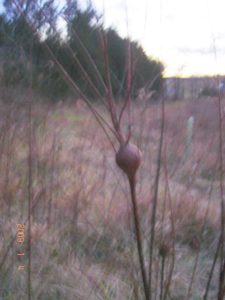
Risks
According to the Canadian Poisonous Plants Information System, some species of goldenrod greens have toxins poisonous to sheep esp., and also horses and calves and plants also can develop a toxic rust–which is a fungus. S. juncea, S. flexicaulis, S.rigida and S. hispida are the most toxic, though other species may also release neurotoxins, especially in fall and winter greens forage. (Burrows, G.E. & Tyrl, R.J., 2013; Canadian Biodiversity Info System)
About this Species
Goldenrods are a very common, showy fall wildflowers that grow in large stands, so you may already have a good mental search image for this genus in your mind’s eye.
I set out armed with my ID books and my camera to identify my local species. Goldenrods are notoriously difficult to identify to the species level for us amateurs. Both authors Newcomb and Peterson gave me clues to help narrow my specimen into fewer species possibilities. The Peterson Wildflowers of Northeastern/North-central North America (Peterson and McKenny, 1968) offers the strategy of selecting a plant silhouette from five choices and then determining whether the leaf is parallel veined or feather veined to further refine the search.
Newcomb’s Guide to Wildflowers (Newcomb, 1977) suggests a strategy based on leaf shape followed by determining the veining patterns.
I also found an online key that really boosted my hope. Discover Life, uses thirteen different criteria to help narrow the field of choices. But in my case it only reduced 35 possible species down to 24.
All these assists, and I still do not know with certainty which goldenrod I have. My best guess at this point?…S. gigantea? S. canadensis? Perhaps a reader will know!
But the good news is that from a foraging for birdseed perspective, as is often the case, it does not matter if you identify to the species level– unless you are trying to avoid harvesting an endangered plant.
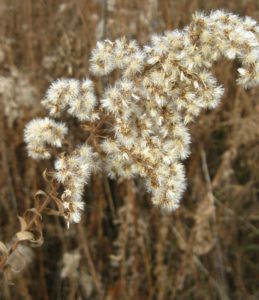
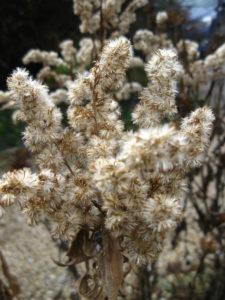
Flower Description: The whole flowering part of the plant (the inflorescence) is a massive group of many tiny flowers arranged in spikes, plumes and other configurations (dependent on species) towards the top third of the tall plant. If you separate out an individual flower from the mass and examine it with a hand lens, you will see the outer “petals” rising out of the bract cup underneath. Since goldenrods are in the aster family, these petals are actually ray flowers and the center of the flower is packed with many more tubular flowers in the center disk. It will be maddeningly difficult to see this individual flower detail, but trust that it is there.
Instead, you will come to recognize goldenrods by the overall mass of golden flowers. In some species the flowers will line up on one only side of the stem. In other species, the flowers cluster at the top. The overall silhouette of the plant varies across species. Peterson’s does a good job of illustrating these profiles as plume-like, elm-branched, club-like, wand-like or flat-topped (Peterson and McKenney,1968).
Once the flowers go to seed, the dead flowers remain on the plant well into winter, though it would be prudent to collect the seed in the fall while the seed will have not yet fallen out and the plants have not been beaten down by snows.
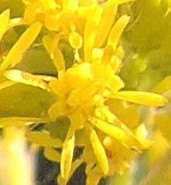
Leaf Description: The most general description across most species of goldenrod in my area is that the leaves are alternate on the stem and are longer than they are wide. They feel rough to touch, like a very fine sandpaper. You will more likely recognize goldenrod from its flowers, which are more consistent in form across species. There are goldenrods with very slender, entire leaf margins (no teeth) to goldenrods with fatter, serrated (toothed) leaves with feather-type veins. Crush the leaf and try to memorize the lovely smell. Some of the veins on goldenrod, though initiating from the main rib, seem to run parallel to the main vein for a good distance.
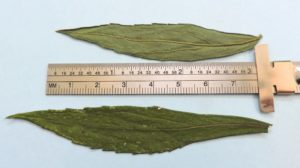
Seed Size: The seeds are oblong and very tiny, about 3/64 inch (1 mm) or about 3/32 inch (2 mm) if you include the pappus hairs.
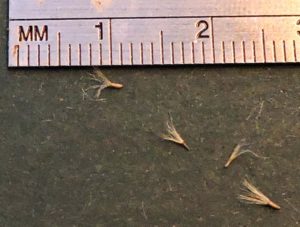
Harvesting
| Jan | Feb | Mar | Apr | May | Jun | Jul | Aug | Sep | Oct | Nov | Dec | ||||||||||||||
|---|---|---|---|---|---|---|---|---|---|---|---|---|---|---|---|---|---|---|---|---|---|---|---|---|---|
| winter | winter | late winter | early spring | spring | late spring | early summer | summer | late summer | early fall | fall | late fall | ||||||||||||||
| seed | x | x | x | ||||||||||||||||||||||
| greens | x | x | x | x | x | x | x | x | |||||||||||||||||
Does this lend itself as a good enrichment item?
Maybe, or perhaps I should say, “it depends”. I have seen goldenrod seedheads that were too delicate to cut and transport without knocking the achenes (seeds) off during transport and installation. I have also seen perfectly mature goldenrod seedheads that appeared not so likely to drop seeds just by looking at them. I recommend running the brown dry seed head through your hand to see how easily the seeds detach. If you think it can make it through cutting and transport without seeding up your car too much, then go ahead and try to cut the whole plant and install it in an enclosure. Keep in mind, however, at some point later on the seeds will likely detach more and blow around in the enclosure, which you may or may not want. But at least it is a native plant!
Harvesting Goldenrod Seed:
Goldenrod goes to seed very late in the year, so it is possible to harvest it in late fall maybe up until snowfall knocks the whole plant down. It is easy to collect a lot of goldenrod seed, but impossible to easily remove the seed from the pappus fluff.
Once the bright golden blossoms mature and fade to beige-tan, cut the stem just below the seed heads and place in a large paper sack to dry further for a few weeks indoors. Many seeds will fall off and accumulate in the bag as a big pile of fluff. Working outside on a windless day, finish removing the remaining seeds by stripping each stem piece by piece through your fingers. Discard stems. I have not found a way to further clean the seed of its pappus hairs. You can rub the seed in your hands which will decrease the seeds overall volume somewhat and make it less likely to “fly-away” in a minor breeze.
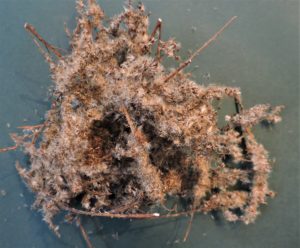
How to Store Prepared Seed: Once cleaned and fully dried, choose a low humidity day—not a rainy day—to jar up your seed.
Glass or metal works best, because all plastics are somewhat porous to humidity. Canning jars and lids work well. Place seed in a tightly sealed, glass container and store in a dark, cool area for up to 1 year. Refrigeration and freezing work well. Label the airtight container with the seed name, date of harvest and which animals it should be used for.
If you intend to keep the seed longer than one year, jar up the seeds in two stages. First, jar the seeds up using a desiccant for up to 1 week. Then check the seed for dryness, and if dry enough, remove the desiccant and immediately repack the seed into an airtight container. Read more about drying seeds and using desiccants.
Keep stored seed in an airtight glass or metal container in a cool, dark place. Refrigeration and freezing works well, but allow container to warm to room temperature before opening. Discard any seed that ever appears moldy.
Harvesting Goldenrod Greens: Goldenrod greens are softer, perhaps more palatable, when young. Most plants get tougher and less succulent as they mature. Stems get firmer or woodier and leaves get tougher and coarser. Aim for young goldenrod leaves in early summer as soon as you can positively identify the plant. The stems are probably not all that palatable; I’d probably strip the leaves off the stems.
Storing Greens: If you choose to, use a commercial vegetable cleaner or a ¼ cup (60 ml) of vinegar added to wash water as a cleaner. Submerge the plant material and swish it around to remove all dirt from leaves and roots. Rinse in clean water. Always wash greens; you never know what might be on them…like animal feces or urine. Place in a colander or salad spinner to drain, then layout a towel and spread the greens on the towel and roll up the towel. Unroll and transfer the damp greens to storage.
For storage, there are a couple of different possible container methods. If the greens will be used quickly within days, place the spun-and-towel-rolled damp greens to a 1 gallon zip-lock baggie with 12-15 holes cut in it to provide air and keep the greens from molding (or reuse commercial grape bags with holes). Label the bag with the plant name and which animals it should be used for. Keep container in the vegetable drawer of the refrigerator.
For storage longer than one week, use a rigid, lidded, airtight container. After washing and salad spinning the greens, place a paper towel in the bottom, then loosely fill with greens, but do not pack them in. Then lay a paper towel on top and put on lid. Keep container in the vegetable drawer of the refrigerator. Do not use if greens become moldy, slimy or dried out.
Many greens are very sensitive to exposure to ethylene gas, though greens themselves are low emitters of the gas. You may get longer quality by adding with a product that reduces free ethylene gas in the refrigerator. Greens are good until they become dry and crispy, fade in color, or become slimy or moldy. Storing Greens.
Other Species:
In my area of Virginia, the other flower that can turn whole fields golden is wingstem. I don’t think it would be too easy to really confuse wingstem with goldenrod, except at the most cursory glance. Wingstem’s long stalks have 4 “wings” that run the length of the stalk and stand out perpendicular to the stalks–goldenrod doesn’t have anything like that. Also wingstem’s flowers are much larger–enough to clearly see flower parts, which are too minute to see easily in goldenrod.
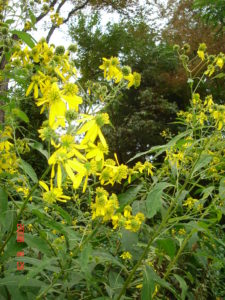
Also, in about fifteen counties in Virginia and in other states, there is another small genus of plants, Oligoneuron, that was previously listed in under the Solidago genus, but are now their own genus based on changes discovered through new genetic understanding. Some of these plants could easily be mistaken for a Solidago goldenrod and many species still use the word goldenrod in their common name. From a wildlife food perspective, I do not believe harm would be done if you offered these Oligoneuron seeds or greens.
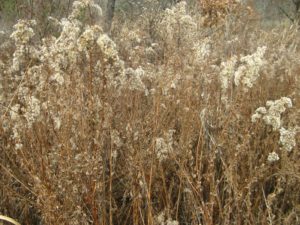
Rare Species in Virginia
Do you live in one of these Virginia counties? If so, be aware that there are some species near you that may be threatened or endangered. Do more research to make sure you are identifying your target species correctly and not harvesting a threatened species!
| County in Virginia | Species | Alert |
| Albemarle | Rand’s goldenrod | Globally appears secure, imperiled in Virginia |
| Amherst | Rand’s goldenrod | Globally appears secure, imperiled in Virginia |
| Augusta | hairy goldenrod | Globally secure, vulnerable in Virginia |
| Augusta | Rand’s goldenrod | Globally appears secure, imperiled in Virginia |
| Bath | hairy goldenrod | Globally secure, vulnerable in Virginia |
| Brunswick | southern rough-leaved goldenrod | Globally secure, extremely close to extirpated in Virginia |
| Buchanan | gorge goldenrod | Globally imperiled and at risk of extinction, vulnerable in Virginia |
| Buchanan | mountain goldenrod | Globally secure, vulnerable in Virginia |
| Chesapeake | twistleaf goldenrod | Globally appears secure, critically imperiled in Virginia |
| Chesapeake | Elliott’s goldenrod | Globally secure, imperiled in Virginia |
| Clarke | hairy goldenrod | Globally secure, vulnerable in Virginia |
| Dickenson | gorge goldenrod | Globally imperiled and at risk of extinction, vulnerable in Virginia |
| Dinwiddie | sandhill goldenrod | Globally appears secure, but vulnerable in Virginia |
| Dinwiddie | wand goldenrod | Globally appears to be secure, imperiled in Virginia |
| Fairfax | rock goldenrod | Globally appears secure, but critically imperiled in Virginia |
| Fairfax | Rand’s goldenrod | Globally appears secure, imperiled in Virginia |
| Fauquier | hairy goldenrod | Globally secure, vulnerable in Virginia |
| Floyd | Rand’s goldenrod | Globally appears secure, imperiled in Virginia |
| Frederick | hairy goldenrod | Globally secure, vulnerable in Virginia |
| Giles | hairy goldenrod | Globally secure, vulnerable in Virginia |
| Giles | gorge goldenrod | Globally imperiled and at risk of extinction, vulnerable in Virginia |
| Grayson | bog goldenrod | Globally appears secure, imperiled in Virginia |
| Greene | Rand’s goldenrod | Globally appears secure, imperiled in Virginia |
| Halifax | southern rough-leaved goldenrod | Globally secure, extremely close to extirpated in Virginia |
| Hampton | Elliott’s goldenrod | Globally secure, imperiled in Virginia |
| Henrico | Elliott’s goldenrod | Globally secure, imperiled in Virginia |
| Henrico | wand goldenrod | Globally appears to be secure, imperiled in Virginia |
| Highland | bog goldenrod | Globally appears secure, imperiled in Virginia |
| Isle of Wight | sandhill goldenrod | Globally appears secure, but vulnerable in Virginia |
| James City | wand goldenrod | Globally appears to be secure, imperiled in Virginia |
| King George | wand goldenrod | Globally appears to be secure, imperiled in Virginia |
| King William | wand goldenrod | Globally appears to be secure, imperiled in Virginia |
| Lee | gorge goldenrod | Globally imperiled and at risk of extinction, vulnerable in Virginia |
| Lee | mountain goldenrod | Globally secure, vulnerable in Virginia |
| Madison | hairy goldenrod | Globally secure, vulnerable in Virginia |
| Madison | Rand’s goldenrod | Globally appears secure, imperiled in Virginia |
| Middlesex | sandhill goldenrod | Globally appears secure, but vulnerable in Virginia |
| New Kent | sandhill goldenrod | Globally appears secure, but vulnerable in Virginia |
| Northampton | Elliott’s goldenrod | Globally secure, imperiled in Virginia |
| Northampton | twistleaf goldenrod | Globally appears secure, critically imperiled in Virginia |
| Page | rock goldenrod | Globally appears secure, but critically imperiled in Virginia |
| Page | hairy goldenrod | Globally secure, vulnerable in Virginia |
| Page | Rand’s goldenrod | Globally appears secure, imperiled in Virginia |
| Patrick | hairy goldenrod | Globally secure, vulnerable in Virginia |
| Pittsylvania | hairy goldenrod | Globally secure, vulnerable in Virginia |
| Rockbridge | hairy goldenrod | Globally secure, vulnerable in Virginia |
| Rockingham | hairy goldenrod | Globally secure, vulnerable in Virginia |
| Rockingham | Rand’s goldenrod | Globally appears secure, imperiled in Virginia |
| Scott | gorge goldenrod | Globally imperiled and at risk of extinction, vulnerable in Virginia |
| Shenandoah | hairy goldenrod | Globally secure, vulnerable in Virginia |
| Southampton | wand goldenrod | Globally appears to be secure, imperiled in Virginia |
| Suffolk | Elliott’s goldenrod | Globally secure, imperiled in Virginia |
| Sussex | wand goldenrod | Globally appears to be secure, imperiled in Virginia |
| Tazwell | gorge goldenrod | Globally imperiled and at risk of extinction, vulnerable in Virginia |
| Virginia Beach | twistleaf goldenrod | Globally appears secure, critically imperiled in Virginia |
| Warren | Rand’s goldenrod | Globally appears secure, imperiled in Virginia |
| Warren | hairy goldenrod | Globally secure, vulnerable in Virginia |
| Wise | gorge goldenrod | Globally imperiled and at risk of extinction, vulnerable in Virginia |
| Wise | mountain goldenrod | Globally secure, vulnerable in Virginia |
| York | Elliott’s goldenrod | Globally secure, imperiled in Virginia |
Feed Goldenrod to:
goldenrod | (Solidago spp.) | greens |
|---|---|---|
 Caution: S. juncea, S. flexicaulis, S.rigida and S. hispida are the most toxic, though other species may also release neurotoxins, especially in fall and winter greens forage. Some species of goldenrod greens have toxins poisonous to sheep esp., and also horses and calves and plants also can develop a toxic rust-- a fungus. (Burrows, G.E. & Tyrl, R.J., 2013; Canadian Biodiversity Information Fac | ||
Cottontail, Eastern | Sylvilagus floridanus |
|
Deer, White-tailed | Odocoileus virginianus |
|
Vole, Meadow | Microtus pennsylvanicus |
|
Vole, Pine | Microtus pinetorum |
|
Voles, various spp. | various species |
|
Grouse, Ruffed | Bonasa umbellus |
|
Grouse, Sharp-tailed | Tympanuchus phasianellus |
|
goldenrod | (Solidago spp.) | roots/tubers/corms |
 Caution: S. juncea, S. flexicaulis, S.rigida and S. hispida are the most toxic, though other species may also release neurotoxins, especially in fall and winter greens forage. Some species of goldenrod greens have toxins poisonous to sheep esp., and also horses and calves and plants also can develop a toxic rust-- a fungus. (Burrows, G.E. & Tyrl, R.J., 2013; Canadian Biodiversity Information Fac | ||
goldenrod | (Solidago spp.) | seeds |
 Caution: S. juncea, S. flexicaulis, S.rigida and S. hispida are the most toxic, though other species may also release neurotoxins, especially in fall and winter greens forage. Some species of goldenrod greens have toxins poisonous to sheep esp., and also horses and calves and plants also can develop a toxic rust-- a fungus. (Burrows, G.E. & Tyrl, R.J., 2013; Canadian Biodiversity Information Fac | ||
Vole, Meadow | Microtus pennsylvanicus |
|
Vole, Pine | Microtus pinetorum |
|
Voles, various spp. | various species |
|
Goldfinch, American | Carduelis tristis | strong preference |
Bunting, Indigo | Passerina cyanea |
|
Bunting, Snow | Plectrophenax nivalis |
|
Finch, House | Carpodacus mexicanus |
|
Junco, Dark-eyed | Junco hyemalis |
|
Redpoll, Common | Carduelis flammea |
|
Siskin, Pine | Carduelis pinus |
|
Sparrow, American Tree | Spizella arborea |
|
Sparrow, Swamp | Melospiza georgiana |
|
goldenrod, Canada | (Solidago canadensis) | greens |
 Caution: S. juncea, S. flexicaulis, S.rigida and S. hispida are the most toxic, though other species may also release neurotoxins, especially in fall and winter greens forage. Some species of goldenrod greens have toxins poisonous to sheep esp., and also horses and calves and plants also can develop a toxic rust-- a fungus. (Burrows, G.E. & Tyrl, R.J., 2013; Canadian Biodiversity Information Fac | ||
Deer, White-tailed | Odocoileus virginianus |
|
Book References:
Burrows, G.E., Tyrl, R.J. (2013) Toxic Plants of North America, 2nd Edition, Oxford, U.K.: John Wiley & Sons, Inc.
Martin, A.C., Zim, H.S., Nelson, A.L. (1951). American Wildlife and Plants: A Guide to Wildlife Food Habits. New York: Dover Publications.
Newcomb, L. (1977). Newcomb’s Wildflower Guide. Boston: Little, Brown and Company.
Peterson, R.T., McKenny, M. (1968). Wildflowers: Northeastern/North-central North America. Boston: Houghton Mifflin Company.
Scott, M. (2013). Songbird Diet Index. National Wildlife Rehabilitators Association, St. Cloud, MN.
Townsend, J. F. (2015, April) Rare Plants Natural Heritage Technical Report 15-10. (Unpublished Report) Richmond, Virginia: Virginia Department of Conservation and Recreation, Division of Natural Heritage.
On-line References:
Canadian Poison Plants Information System. (n.d.) Retrieved on 8/6/17 from the Canadian Biodiversity Information Facility at http://www.cbif.gc.ca/eng/species-bank/canadian-poisonous-plants-information-system/canadian-poisonous-plants-information-system/?id=1370403266275
Coladonato, Milo. 1993. Solidago canadensis. In: Fire Effects Information System, [Online].
U.S. Department of Agriculture, Forest Service, Rocky Mountain Research Station, Fire Sciences Laboratory (Producer).
Available: http://www.fs.fed.us/database/feis/plants/forb/solcan/all.html [2016, December 23].
Goldenrod (n.d.). Retrieved on December 2, 2015 from http://www.discoverlife.org/
USDA, NRCS. 2015. The PLANTS Database (http://plants.usda.gov, 4 January 2016). National Plant Data Team, Greensboro, NC 27401-4901 USA.
Virginia Botanical Associates. (Accessed January 2016). Digital Atlas of the Virginia Flora (http://www.vaplantatlas.org). c/o Virginia Botanical Associates, Blacksburg.

